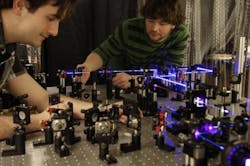Frontiers in Optics 2012: Weak measurements on photons push past Heisenberg's precision limit
Toronto, ON, Canada--Researchers at the University of Toronto have gathered the most direct experimental evidence yet that Werner Heisenberg's original formulation of his uncertainty principle is wrong. The group used many weak measurements on entangled photons, an approach that surpasses the precision of the more-conventional single strong measurement.
(It should be noted that this does not disprove the rigorously proven generalized equations of the Heisenberg Uncertainty Principle; what it does disprove is the commonly used, looser interpretation of the Heisenberg Uncertainty Principle in which it is interpreted as a “measurement-disturbance relationship” describing the relationship between the precision of a measurement and the disturbance it ultimately creates.)
The results were published online in the journal Physical Review Letters last month and the researchers will present their findings for the first time at the Optical Society's (OSA) Annual Meeting, Frontiers in Optics (FiO), taking place Oct. 14-18, 2012 in Rochester, NY.1
Info built up from repeated weak measurements
The Toronto team set up an apparatus to measure the polarization of a pair of entangled photons. The different polarization states of a photon, like the location and momentum of an electron, are complementary physical properties and are thus subject to the generalized Heisenberg uncertainty relationship. The researchers' main goal was to quantify how much the act of measuring the polarization disturbed the photons, which they did by observing the light particles both before and after the measurement. However, if the "before shot" disturbed the system, the "after shot" would be tainted.
The researchers found a way around this quantum-mechanical conundrum by using techniques from quantum-measurement theory to sneak nondisruptive peeks of the photons before their polarization was measured. "If you interact very weakly with your quantum particle, you won't disturb it very much," explains Lee Rozema, a Ph.D. candidate in quantum optics research at the University of Toronto, and lead author of the study. Weak interactions, however, yield very little information about the particle. "If you take just a single measurement, there will be a lot of noise in that measurement," says Rozema. "But if you repeat the measurement many, many times, you can build up statistics and can look at the average."
By comparing thousands of "before" and "after" views of the photons, the researchers revealed that their precise measurements disturbed the system much less than predicted by the original Heisenberg formula. The team's results provide the first direct experimental evidence that a new measurement-disturbance relationship, mathematically computed by physicist Masanao Ozawa, at Nagoya University in Japan, in 2003, is more accurate.
FOOTNOTE
1. Presentation FW4J.4, "Direct Violation of Heisenberg's Precision Limit by Weak Measurements," takes place Wednesday, Oct. 17, 2012 at 2:30 p.m. EDT at the Rochester Riverside Convention Center in Rochester, NY.

John Wallace | Senior Technical Editor (1998-2022)
John Wallace was with Laser Focus World for nearly 25 years, retiring in late June 2022. He obtained a bachelor's degree in mechanical engineering and physics at Rutgers University and a master's in optical engineering at the University of Rochester. Before becoming an editor, John worked as an engineer at RCA, Exxon, Eastman Kodak, and GCA Corporation.
